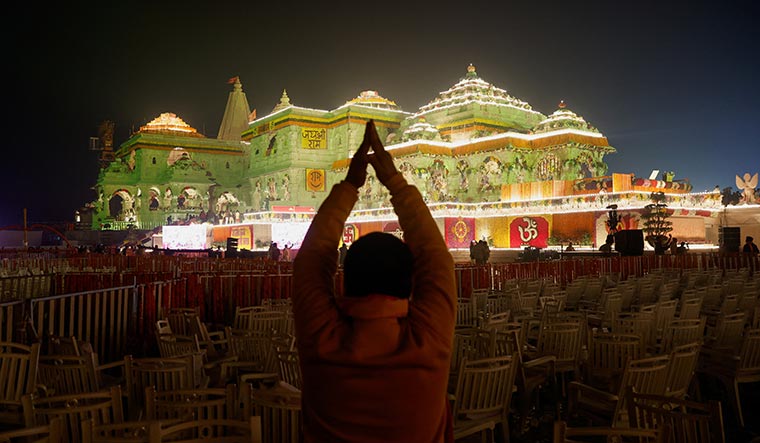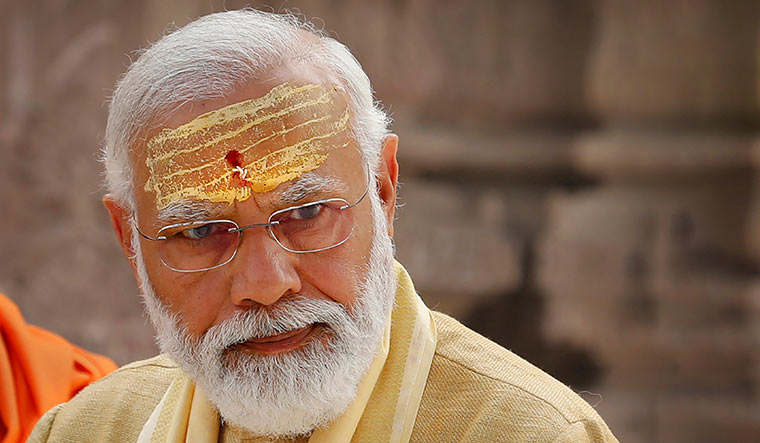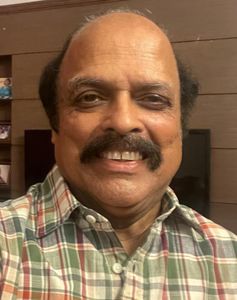Modi ki Guarantee―Ram Lalla Darshan Yojana.
The promise, displayed on giant hoardings, is what welcomes you to Raipur as you exit the airport. Even those who live in the hinterlands of Chhattisgarh have been assured of a darshan at the Ram Temple in Ayodhya if Prime Minister Narendra Modi retains power after the Lok Sabha polls.
Sure enough, the grand new Ram Temple has become the focal point of the BJP’s campaign in heartland states―Chhattisgarh, Madhya Pradesh, Rajasthan, Haryana, Jharkhand, Uttarakhand, Bihar and Uttar Pradesh. Together, these states have 214 of 543 Lok Sabha seats, and Modi hopes they will power him to victory for a third consecutive time. The BJP has, indeed, left no stone unturned to woo south India―the Ram idol in Ayodhya was sculpted in stone by a Mysuru artist―but the party continues to depend heavily on support from the Hindi heartland.
Barring Uttar Pradesh, the BJP-led National Democratic Alliance won almost all the seats in all these states in 2019. So the BJP has its task cut out: raise its UP tally while maintaining the high numbers in all other states.
The party won 62 seats in UP in 2019, down from 71 in 2014. Its ally Apna Dal won two seats in 2019. The Bahujan Samaj Party (BSP), which drew a blank in 2014 and won 10 seats in 2019 (in a brief alliance with the Samajwadi Party), has become so dormant that even its supporters share the common perception that party chief Mayawati has yielded to the BJP. With senior BSP leaders having joined other parties, the 10 seats are up for grabs. The SP, which won only five seats in 2019, is out to regain its lost domain, while the Congress is struggling to look beyond Raebareli, the lone seat won by party leader Sonia Gandhi. With Sonia having moved to the Rajya Sabha because of her ill health, and Rahul Gandhi having been defeated in Amethi in 2019, the Congress’s prospects remain bleak.
The BJP is heavily depending on Chief Minister Yogi Adityanath, who maintains his reputation as a master polariser, to make gains in UP. But the common impression is that he is not on the best of terms with Amit Shah, Modi’s man Friday and Union home minister, who actually calls the electoral shots. No wonder that ‘Ram Lalla darshan’, the icing on the ‘Modi guarantees’ cake, is dominating his campaign in heartland states.
The guarantees themselves are reiterations of the welfare schemes that Modi has initiated over the past ten years. Interestingly, while Modi is tireless in describing similar welfarist schemes by his rivals as “rewri batna (distribution of freebies)”, he does not hesitate to boast about his welfare push in the name of “Modi ki guarantee”. The darshan guarantee, especially, seems to have already taken the BJP ahead of its rivals in the Hindi belt.
The party has long been trying, overtly and covertly, to polarise voters by shrewdly playing the hindutva card. Facts have been tweaked or distorted, and incidents blown out of proportion, to achieve desired results. The most glaring example in recent years relates to the beheading of Kanhaiya Lal, a tailor in Udaipur, Rajasthan, by two Muslim extremists in June 2022. The Rajasthan Police, under Chief Minister Ashok Gehlot, arrested the assailants in just two hours, but the BJP claimed that the arrest was made only after the Union government handed over the case to the National Investigation Agency. While Gehlot gave a compensation of Rs50 lakh to Kanhaiya Lal’s family, and provided jobs for two family members, the BJP created a story that only Rs5 lakh was given to Lal’s family, while Rs50 lakh was doled out to a Muslim who was killed in a case of road rage in Jaipur.
Such claims, amplified by the media, paid the BJP rich dividends in the Rajasthan assembly polls last year. With the Congress failing to effectively counter the disinformation campaign, the polarisation of votes brought down the Gehlot government.
A more recent instance of such a campaign was when Congress leader Rahul Gandhi remarked about Modi’s shakti (power) in capturing “institutions, industry, media and the entire constitutional structure of the country”. Modi gave it a twist, and declared that Rahul had made a derogatory comment against the goddess Shakti. Rahul’s assertion that he was not referring to any divine power, but to the power of corruption and falsehood, hardly gained currency. Also, BJP workers in the heartland states made it a mission to portray Rahul as “anti-Hindu”.
Evidently, to attain its target of winning more than 400 seats for the NDA and to realise the long-cherished RSS dream of making India a Hindu Rashtra, the BJP seems to be orchestrating a communal divide. The foundation of this Hindu Rashtra was, perhaps, laid on January 22, when the prime minister himself, on behalf of the state, carried out the consecration of the Ram Temple in Ayodhya. The message was loud and clear―Modi was well above all priests and pontiffs.
 A prayer for votes: A devotee near the Ram Temple in Ayodhya after its inauguration on January 22 | Reuters
A prayer for votes: A devotee near the Ram Temple in Ayodhya after its inauguration on January 22 | Reuters
Modi has been able to sell this hindutva card with impunity. The BJP has also been impressing upon its audience that it was Modi who brought the 500-year-old dispute over the temple to its logical conclusion. TV and newspaper advertisements, and roadside hoardings, show the prime minister holding the hand of a five-year-old child symbolising Ram Lalla―thus demonstrating the BJP’s slogan ‘Ye laye hain Ram ko’ (He has brought Ram). Such gimmicks sell well in the heartland.
The messaging also helped the BJP install an idol of a five-year-old Ram in the sanctum sanctorum of the new temple, sidelining the original idol of new-born Ram that had appeared inside the Babri Masjid in December 1949. The legal battle for rights over the plot on which the sixteenth-century Babri Masjid stood had begun after this appearance in 1949. The BJP has systematically underplayed the fact that it was only after the Supreme Court delivered its verdict on the title case in 2019 that the construction of the Ram Temple could begin. People are now being told that, if not for Modi, the temple would not have become a reality.
Since there are not many Ram temples in India, a grand temple dedicated to Ram at his “birthplace” gains all the more significance. It allows the BJP to focus on the popular belief that the masjid was erected at the very spot where once an ancient Ram temple stood.
The transformation of Ayodhya from an ancient temple town into a modern Hindu pilgrimage centre, with star hotels and a state-of-the art railway station and international airport, has been attracting devotees from across India. But recent reports say the footfall in Ayodhya has been falling steadily. It is hardly good news for the BJP. No wonder that BJP-ruled states are sponsoring Ayodhya free-rides in the run-up to the Lok Sabha polls. As this writer found, a large number of Hindus in all such states were looking to make use of the opportunity.
 The big hitters: Union Home Minister Amit Shah (right) and Uttar Pradesh Chief Minister Yogi Adityanath | PTI
The big hitters: Union Home Minister Amit Shah (right) and Uttar Pradesh Chief Minister Yogi Adityanath | PTI
Interestingly, the pilgrimages are being monitored not just by the state governments, which have been readily bearing the cost of travel, but also by the Prime Minister’s Office. For Modi, apparently, every single vote matters.
Modi’s poll-speak also seems to be having grassroots impact, even though it may appear to be a bundle of contradictions. His proclamations about India’s economy touching new heights are in sharp contrast to free rations for 80 crore people who could well go hungry otherwise. But, ultimately, such freebies―cooking gas connections under the Ujjwala scheme, or a toilet for every household―resonate with the masses across the heartland. They could even override traditional caste alignments.
States where the BJP is in power have been on a publicity blitz to cloak the problem of rising prices and unemployment. UP’s publicity budget is 01,450 crore, and multinational consultancy firms have been spinning statistics to win votes. The publicity drive has apparently been so successful that even Gehlot, who had introduced a free medical treatment scheme that was better than the Modi government’s much-publicised Ayushman Bharat scheme (which provides a health cover of 05 lakh per family per year), is finding it difficult to score over Modi’s guarantees.
In Madhya Pradesh, too, the Congress has not been able to showcase the achievements of its government under Kamal Nath, which was brought down by the BJP in 2020. In Chhattisgarh, Bhupesh Baghel of the Congress had done more as chief minister on the welfare front than his predecessor, three-time chief minister Raman Singh of the BJP. But Baghel lost the assembly polls last year, and is now contesting the Lok Sabha polls from Rajnandgaon. He has the uphill task of combating Modi’s aggressive campaign positioning himself as a saviour of tribals to win a seat that the Congress had last won 17 years ago.
The elections are being fought by the BJP essentially in Modi’s name. For the man on the street, Modi is the BJP and the BJP is Modi. Fulfilling Modi’s dream of getting a third term, and reaching the much-hyped target of 400 seats, remain the dominant theme of the party’s poll campaign.
Intimidating and browbeating the opposition appears to be becoming the order of the day. The arrests of former Jharkhand chief minister Hemant Soren and Delhi Chief Minister Arvind Kejriwal, and the looming threat on other opposition leaders, make it evident that Modi wants to paralyse the opposition.
Apart from the CBI and the Enforcement Directorate, the income tax department has also become a tool for arm-twisting.
In a news conference in Delhi in March, Congress leaders Mallikarjun Kharge, Sonia Gandhi and Rahul Gandhi accused the Union government in general and Modi in particular of trying to financially cripple the Congress by freezing its bank accounts “in violation of the prevailing IT laws”. Terming the move as an attempt to deny a level playing field during the polls, they said the Congress was not in a position to even buy a rail ticket or book advertisement slots in the media, let alone fund its candidates or carry out other routine poll-related activities. Rahul described the IT department’s action as “criminal”.
Also Read
- Who will benefit from community and caste divide, BJP or Congress?
- Akhilesh Yadav: It's in BJP's identity to make promises and then forget
- Can a united Congress in Rajasthan exploit divisions in BJP?
- Ashok Gehlot: People can see through BJP's divisive politics
- Congress not weakened by desertions in Rajasthan: Govind Dotasra
- Can Shivraj Singh Chouhan factor help BJP woo women voters in Lok Sabha too?
The opposition’s allegation that electronic voting machines were being “manipulated” was recently dismissed as a trivial joke by Chief Election Commissioner Rajeev Kumar. Also glaring is the fact that the commission has not cared to grant an audience to 26 opposition parties that had sought to raise the issue directly before it.
Thankfully, an intervention by the Supreme Court did force the government to let the State Bank of India finally disclose all details regarding electoral bonds. Significantly, this was the first time that the government found itself cornered by the opposition.
Electoral bonds-related irregularities have become a talking point in heartland states, even though mainstream media has been underplaying it. A lot will depend on how the opposition spreads the message among common voters that the Modi government may well have skeletons in its cupboard.
But, even if the opposition succeeds in it, there remains a million-dollar question―can it override the BJP’s efforts to overwhelm voters with the aura of the Ram Temple?
Sharat Pradhan is an independent journalist and author of Yogi Adityanath: Religion, Politics and Power―The Untold Story.



